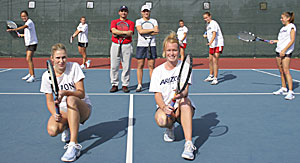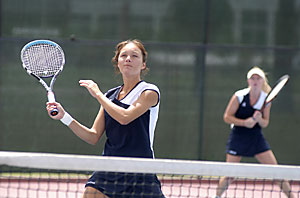 |
|
JACOB KONST/Arizona Daily Wildcat
|
The UA's 2004-2005 women's tennis team comes from all over the world, with each player from a different country. From left to right: Jessie Rochefort, Dianne Hollands, Kasia Jakowlew, Kelly Perry, Maja Mlakar, Stephanie Balzert and Camelia Todorova.
|
|
|
By Michael Schwartz
Arizona Daily Wildcat
Wednesday, January 26, 2005
Print this
Athletes come from all over the globe, spend hours on the practice court in preparation for competition and learn from their fellow players who all bring something else to the cultural mix.
While this sounds like a night in Olympic Village, it also describes the Arizona women's tennis team, which features eight players all born in different countries.
Led by seniors Dianne Hollands of New Zealand, Maja Mlakar of Slovenia and the lone American-born player, Kelly Perry, the squad has been transformed into its own international community thanks to the recruiting efforts of fourth-year coach Vicky Maes, herself a former Wildcat recruited from Belgium.
The team also features juniors Stephanie Balzert from Germany and Brazil's Iza Ferriera. Kasia Jakowlew, a sophomore from Sweden, sophomore Jessie Rochefort of Canada and freshman Camelia Todorova, who was born in Bulgaria but moved to San Diego at a young age, round out the squad. Each player brings something different to the table both on the court and off it.
Maes said that Arizona tennis has gone the international route since she played from 1995 to 1998, estimating that more than half her team was composed of foreign players. The Wildcats have no other choice besides going overseas if they wish to compete with the top schools in the country.
"I think it's necessary to bring in people from all over the world because it's very difficult to compete with a Stanford or a Florida," she said. "They're so tough, they get all the top Americans, they reload every year and for us to even have a chance to compete in the Pac-10 we need to broaden our recruiting fields a little bit."
Even with all of the different first languages on the court, Maes, Mlakar and Perry all agreed that communication is no problem. Maes said that's because she only recruits players who speak well enough English to eliminate any communication problems and to make sure they do well in school.
"They all speak English," Mlakar said. "We all get along really well. It's just good to know all the different mentalities from the different cultures. It's really not a problem communicating."
 |
|
JACOB KONST/Arizona Daily Wildcat
|
Sophomore Jessie Rochefort, left, and senior Kelly Perry compete last season in doubles competition against Washington.
|
|
|
So many foreigners jump at the opportunity to play college tennis in the United States because there are no college sports in Europe, according to Mlakar. Since she would not be playing college tennis if she stayed home, going abroad provided the perfect opportunity to play tennis and get a free education.
While Mlakar said it was hard to leave her parents and only sees them twice a year, her teammates have helped make the adjustment smoother.
"It wasn't as hard as it would be for a normal student just because I came right into a group of my teammates," she said. "(I had) a group of friends right away so I didn't have a hard time finding friends and stuff. It's good because we're in the same situation. We're all from different countries, so we have each other."
Besides all the players in this same situation, the women also have a coach who encountered the same circumstances. Besides her European recruiting contacts, Maes' background helps foreign players choose Arizona and feel comfortable when they arrive on campus.
"I think it helps that the girls come in knowing that they have somebody here who has gone through the same thing, who also came in being far away from home," Maes said. "I think that they appreciate that I can relate to what they're going through and so I think in that regard it does help."
Maes said the great thing about her team is that everybody brings something to the group from their different backgrounds to form a melting pot of a squad.
"College is about growing and it's about learning and ultimately I think having them work on a team not only having tennis but also having this cultural experience added to their college experience is a great thing," she said. "They learn to work together. They all come from different backgrounds, different financial situations yet here they are working together towards a common goal and finding a way to do that. This team that I have this year, they get along so well and it's really fun to work with them and see them work together."
While Perry lives within driving distance, hailing from San Diego, she said she likes the international environment that this team fosters. It has broadened her horizons and helped her learn more about the world without going far from home.
"It feels like I've been to all these countries, and I haven't been yet because of all the cultures coming in," she said. "Things are funny because I feel like I'm teaching something to them every day, and I learn something new every day. I'm learning different foods and stuff like that, but it's fun. I love it, and I wouldn't have it any other way."
The women's tennis team is not the only team on campus taking the global approach. Right across the nets, the men's team sends out five foreign players, including junior ace Roger Matalonga of Spain and freshman Claudio Christen, who just came in from Switzerland at the semester break.
Even the UA men's basketball team, which has had no trouble recruiting top American players in recent years, signed Australian guard Daniel Dillon, Puerto Rican guard Jesus Verdejo and forward Mohammad Tangara from Mali this year after bringing in forward Ivan Radenovic from Serbia-Montenegro last year.
"I think it's a good thing for the game because it brings a lot of talent from all over the world to the United States," Maes said. "It means that play is better and the tennis becomes more competitive, so I think it's great for that. For my own personal team I think it's great for everybody to not only just come here to play tennis but to have this amazing cultural experience, to learn to work together and that's something that ultimately when they go into the working world they're going to have to deal with."
While it's positive for Wildcat players to be exposed to cultures from around the world on top of the trials and tribulations of college tennis, this strategy also coincides with winning.
"We'll take the global approach until we feel like we can recruit the best Americans," Maes said. "If I can get some of the top Americans to commit to Arizona, I'd be very happy to do that. Ultimately, what I'm trying to do is get the best team I can possibly put together, and if that means I have to go abroad, then that means I'm going to go abroad."
When Arizona coaches go overseas, they're bringing home more than athletes to make their teams successful. They also add to their squad's cultural diversity, which prepares student-athletes for the real world more than any game-winning shot.
